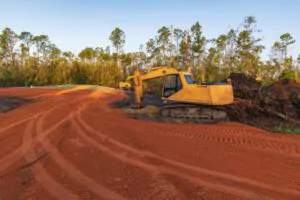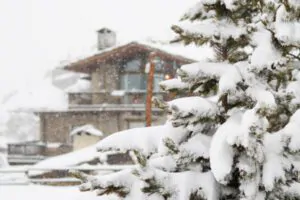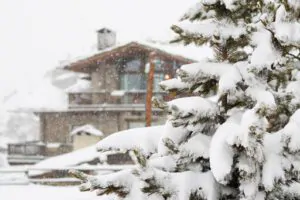
The threat of winter damage to your trees comes with the ice, snow, and cold temperatures of the winter months. Your trees are vulnerable to the dangers of winter even though they are dormant during this time of year. Despite the fact that they are susceptible to damage during the colder months, the extent of damage rarely becomes apparent until spring.
During the winter, there are a few specific events that can harm your trees.
1. Damage from strong winds
Strong winds from snowstorms can severely damage your trees. The wind can dry out some trees’ leaves and branches, causing them to turn brown. Similar to human skin, trees may struggle to obtain sufficient moisture during the winter. The absence of moisture in the air and soil results in a dry environment. Additionally, strong winds could uproot trees in the worst-case scenario. Exposed roots are much more likely to be affected by cold damage.
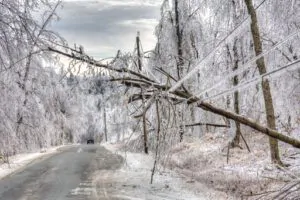
2. Heavy snow and ice on tree branches

Due to the heavy weight of snow and ice on tree branches, trees can become permanently swayed and deformed. Especially trees with broad branches and leaves because they are less resistant to damage of this kind.
Ice damage causes tree branches to become brittle and prone to breaking. Ice accumulation can also be substantial enough to split trees when combined with strong winds.
Ice can add weight and increase the likelihood of limb breakage in the winter. If your trees are properly pruned, and dead limbs are removed, this liability will be reduced. Most of the time, trees that are bent but not broken by the weight of the ice will recover without any extra care. However, a certified arborist is required for any tree that is clearly damaged, leans, or has lost its crown in order to assess its health and damage.
Learn Why It Is Important To Prune Your Trees
3. Changing Temperature
Trees can suffer serious damage from cold temperatures and sudden temperature changes in a short period of time. When the layers of a tree contract in various ways, frost cracks, which are horizontal splits in the outer surfaces of the tree, can form. These cracks can heal, but they usually happen once a year.

Temperature fluctuations can cause frost cracking and sunscald. Sunscald is a condition in which the outer bark is damaged by daytime and nighttime temperature fluctuations. When the sun warms the exposed bark on sunny days, the dormant cells of the tree are brought back to life. These newly activated cells are damaged when nighttime temperatures fall below freezing. The bark slowly clouds, becomes bronzed brown, and ends up breaking and falling. Sunscald is also called Southwest Winter Injury because the part of the tree that faces south and southwest gets the most heat from direct sunlight and is more likely to be damaged than other parts.
4. Salt for the Walkway
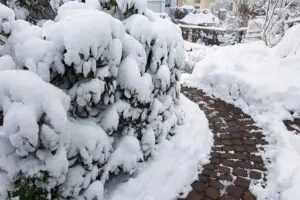
Using salt for the walkway to defrost icy formations can be harmful to newly established leaves. It has the potential to alter the composition of the soil and lead to excessive leaf drying, which eventually results in browning.
5. Stray Animals
Aside from the snowstorms, animals also pose harm to your trees and shrubs this winter. They eat your plants and tree bark, which can seriously damage your plants. Some animals, like mice, tend to nest in shrubs. To prevent this, you can add vegetation around your shrubs and trees or put plastic guards around them.

How to cover a tree for winter
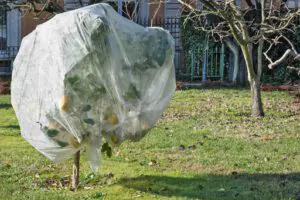
Now that we know how snowstorms affect your trees, we must act and protect them with tree coverings for winter. According to the University of Minnesota, the following are some coverings that are suggested for you to use in order to avoid snow damage to trees.
1. Mulch made of shrunk wood. Shredded mulch can help shield your trees’ roots, particularly those of young plants, from snowstorm damage. It can support the tree and prevent accidental roots from growing.
2. White Guards. Applying white guards to the trunk to reflect the sun and maintain a constant temperature for the bark, thereby preventing sunscald. After the last frost, remove the wrap from the plant in the spring.
3. Carpet, strong fabric, or nylon stockings. These can aid in preventing damage to tree trunks and branches caused by snow and ice. Wrapping relatively small trees together or securing the leaders with nylon stockings, strong cloth, or carpet strips two-thirds of the way above the weak areas is an effective method. In the spring, remove these coverings to stop the stem from girdling and allow it to move freely.
Contact the Reliable Tree Care Service in Waymouth MA

By removing snow and ice from trees and keeping the roots warm, winter storm damage can be avoided. The tree may recover faster by trimming any broken branches behind the break. But If the damage is more severe, like exposed roots, or has large broken branches, or downed trees in a snowstorm, you should call a tree removal and repair company in the South Shore. Green Tech Tree Care Services would be happy to assist you. Contact us at 781-767-3888 & get a free estimate.

